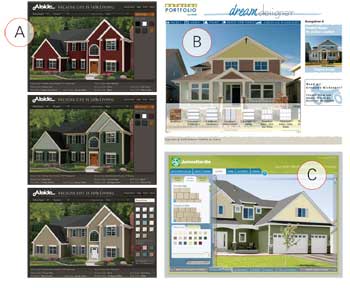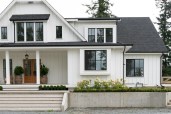Gone Viral
“All the trends we see are going digital. People used to [show exterior options] with color overlays,” Garber says. “It was extraordinarily expensive; you never could get past the generic aspect, and really tough to do but people still wanted it. So this takes it to a new level–so much faster, so much less expensive.”
Market studies and industry professionals agree that an Internet-derived demand for customization and greater options has taken the residential sector by storm. John Burns Real Estate Consulting, an independent housing research, advice, and consulting firm, polled almost 10,000 consumers and found personalization was more important than ever in the decision to buy a home, greater even than investment potential or income tax benefits.
“That’s what this generation wants,” Ziminski says of customization. “So we are investing heavily [in these online tools] as that market is beginning to change to make sure consumers can do some online design work on their own or with an architect.”
And Garber promises the software will only get better: “The graphics will improve; you’ll be able to do all kinds of things, probably explode the roof off and dive into the house and see the insulation in the walls. Like with everything that happens online, it will just get faster, better looking, and probably less and less expensive.”
Siding Stats
Principia Partners predicts residential siding demand in North America will grow about 7% each year to hit $5.6 billion in 2012. The current 3:1 ratio of spending for remodeling and renovation vs. new construction spending will tighten to 2:1.
Darker colors, insulated vinyl siding, and cellular vinyl are not game changers, Principia concludes, based on the uptick by competitors: fiber cement, masonry veneer, and engineered wood alternatives.
The Census Bureau says 36% of new single-family homes completed in the U.S. last year sported vinyl siding as the principal type of exterior wall material, followed by brick (23%), stucco (17%, and fiber cement (13%).
Fiber cement, stucco, and brick siding will grow the fastest through 2014, according to Freedonia, an industry research and analysis group; fiber cement because it’s durable and imitates high-end materials such as wood and brick; stucco because it’s cost effective, easy to install, low maintenance, and durable; and brick for its resistance to fire, its durability, and its aesthetic qualities.
Wood siding had the second-largest market share in 2009, but the future shows a steady decline as fiber cement and stucco take over, Freedonia forecasts. Rotting, maintenance, and durability issues are the cause of the slide.
The 2011 Brand Use Study by Builder magazine asked nearly 3,500 builders for their top siding picks for product quality and published the capital contenders:
Vinyl: Reynolds, CertainTeed, and Georgia-Pacific Siding
Brick: Belden, General Shale, and Boral
Fiber cement: HardiePlank and Artisan by James Hardie, and WeatherBoards by CertainTeed
Stucco: Dryvit Engineered wood: Georgia-Pacific, LP SmartSide, and TruWood


